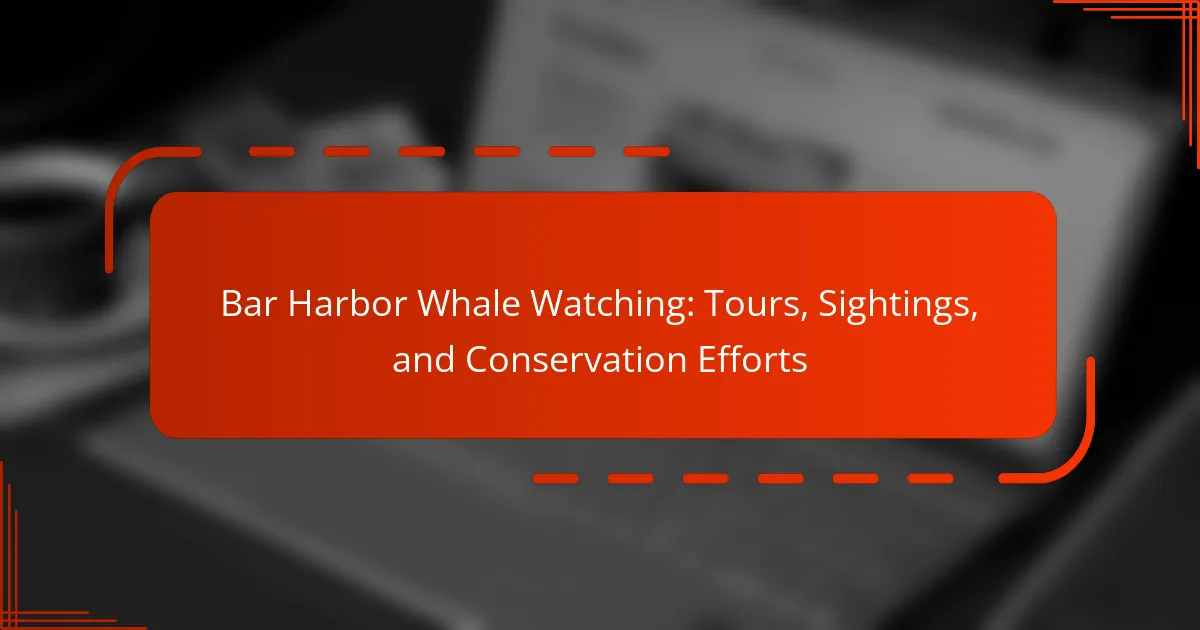Bar Harbor Whale Watching refers to guided tours designed for observing various whale species in their natural habitat off the coast of Bar Harbor, Maine. These tours, led by experienced naturalists, last several hours and typically feature sightings of humpback, minke, and finback whales, especially between late May and early October when whales migrate to the Gulf of Maine. Participants not only enjoy stunning coastal views and the chance to see other marine wildlife but also contribute to conservation efforts by supporting local initiatives and practicing responsible tourism. The article will provide detailed information on the timing of whale sightings, the significance of conservation, and how tourists can engage in eco-friendly practices during their whale watching experience.

What is Bar Harbor Whale Watching?
Bar Harbor Whale Watching is a guided tour experience focused on observing whales in their natural habitat. It operates primarily in the waters off the coast of Bar Harbor, Maine. The tours typically last several hours and are conducted by experienced naturalists. They provide insights into marine life, including various whale species. Common sightings include humpback whales, minke whales, and finback whales. The tours contribute to conservation efforts by promoting awareness of marine ecosystems. Participants often enjoy breathtaking views of the coastline and the opportunity to see other wildlife. Bar Harbor Whale Watching is a popular activity for both tourists and locals.
How did Bar Harbor become a popular whale watching destination?
Bar Harbor became a popular whale watching destination due to its strategic location along migratory routes of whales. The waters off Bar Harbor are rich in marine life, attracting various whale species. Tour operators began offering whale watching excursions in the 1980s, capitalizing on this natural abundance. The establishment of Acadia National Park also increased tourism in the area. Public awareness of marine conservation further boosted interest in whale watching. Research indicates that more than 20 species of whales can be spotted near Bar Harbor. This combination of factors solidified Bar Harbor’s reputation as a prime whale watching location.
What geographical features contribute to whale sightings in Bar Harbor?
The geographical features that contribute to whale sightings in Bar Harbor include the proximity to the Gulf of Maine and the presence of deep underwater canyons. The Gulf of Maine is rich in marine life, providing a feeding ground for whales. The underwater canyons create upwellings that bring nutrient-rich waters to the surface. These upwellings attract small fish and plankton, which in turn attract larger marine animals like whales. Bar Harbor’s coastal location offers easy access to these productive waters. Additionally, the area’s seasonal migrations of various whale species align with the availability of food sources. These factors collectively enhance the likelihood of whale sightings in Bar Harbor.
What types of whales are commonly seen in the Bar Harbor area?
The types of whales commonly seen in the Bar Harbor area include humpback whales, minke whales, and fin whales. Humpback whales are known for their acrobatic behaviors and distinctive songs. Minke whales are the smallest baleen whales and are often spotted during their feeding activities. Fin whales, the second-largest whale species, can also be observed in the region. These species are frequently sighted during the summer months when they migrate to the area for feeding. Bar Harbor is known for its rich marine biodiversity, making it a prime location for whale watching.
What are the different types of whale watching tours available in Bar Harbor?
Bar Harbor offers several types of whale watching tours. These include boat tours, which vary in size from small vessels to large cruise ships. Some tours focus on specific whale species, like humpback or minke whales. Others provide educational experiences with marine biologists on board. Sunset whale watching tours are also popular, offering unique views during twilight. Private charters are available for personalized experiences. Additionally, some tours combine whale watching with other activities, such as kayaking or sightseeing. Each tour type caters to different preferences and group sizes, ensuring a range of options for visitors.
How do half-day and full-day tours differ in Bar Harbor?
Half-day and full-day tours in Bar Harbor differ primarily in duration and content. Half-day tours typically last around 3 to 4 hours. They focus on a limited area and may offer fewer whale sightings. Full-day tours generally last 6 to 8 hours. These tours cover a larger area and provide more opportunities for whale encounters. Full-day tours often include additional activities, such as lunch or educational talks. The extended time allows for a more comprehensive experience of the local marine ecosystem. Thus, the choice between half-day and full-day tours depends on the desired depth of exploration and time availability.
What unique experiences do private charters offer for whale watching?
Private charters for whale watching offer personalized experiences tailored to individual preferences. These charters provide smaller group sizes, allowing for more intimate interactions with marine life. Guests often receive customized itineraries based on current whale activity and weather conditions.
Private charters also enable closer proximity to whales, enhancing visibility and engagement. Many charters include expert guides who share in-depth knowledge about whale behavior and conservation efforts. Some charters offer unique amenities, such as gourmet meals or onboard educational sessions.
Additionally, private charters can accommodate special requests, such as photography sessions or celebrations. This level of customization enhances the overall experience, making it memorable and unique.
What can visitors expect during a whale watching tour in Bar Harbor?
Visitors can expect to see various whale species during a whale watching tour in Bar Harbor. Common sightings include humpback whales, minke whales, and occasionally, finback whales. Tours typically last between three to five hours. Experienced guides provide educational commentary throughout the trip. Visitors may also observe other marine wildlife, such as seals and seabirds. The tours operate in the Gulf of Maine, known for its rich marine biodiversity. Optimal viewing seasons are from late spring to early fall. Many tours guarantee sightings or offer a complimentary trip if no whales are seen.
What safety measures are in place for participants on whale watching tours?
Whale watching tours implement several safety measures for participants. These include mandatory life jackets provided for all passengers. Crews conduct safety briefings before departure to inform participants of procedures. Vessels are equipped with first aid kits and emergency equipment. Additionally, trained crew members monitor weather conditions and marine wildlife behavior. Tours often have a maximum capacity to ensure comfort and safety. Communication devices are on board for emergency situations. Regular maintenance checks on vessels are conducted to ensure safety standards. These measures collectively enhance the safety of participants during whale watching tours.
How do tour guides enhance the whale watching experience?
Tour guides enhance the whale watching experience by providing expert knowledge and engaging narratives. They educate participants about whale species, behavior, and migration patterns. This information enriches the viewing experience. Guides also ensure safety and compliance with regulations. They help locate whales effectively, increasing the chances of sightings. Their enthusiasm and storytelling create a memorable atmosphere. Studies show that guided tours lead to higher satisfaction rates among participants. Overall, tour guides play a crucial role in making whale watching enjoyable and educational.

What are the best times of year for whale watching in Bar Harbor?
The best times of year for whale watching in Bar Harbor are from late May to early October. During this period, various species of whales migrate to the Gulf of Maine. Humpback whales, minke whales, and finback whales are commonly sighted. Peak sightings typically occur between July and August. Weather conditions during these months are also favorable for boat tours. According to the National Oceanic and Atmospheric Administration (NOAA), this timeframe aligns with the whales’ feeding patterns in the region.
How does the whale migration pattern affect tour availability?
Whale migration patterns directly influence the availability of tours. During migration seasons, certain whale species are more likely to be spotted. This increases demand for whale watching tours in specific locations. Conversely, when whales are not present, tour availability may decrease. For instance, humpback whales migrate from feeding grounds in the North Atlantic to breeding grounds in warmer waters. This migration typically occurs from late spring to early fall, aligning with peak tour seasons. Tour operators adjust schedules based on these patterns to optimize sightings. Understanding these migrations helps ensure tours are offered when whales are most likely to be seen.
What months are considered peak whale watching season in Bar Harbor?
Peak whale watching season in Bar Harbor occurs from mid-April to mid-October. During these months, various whale species, including humpback and minke whales, are frequently spotted. The warm waters attract whales as they migrate for feeding. Tour operators report the highest sightings in July and August. These months coincide with optimal weather conditions for whale watching.
What weather conditions should visitors consider before booking a tour?
Visitors should consider temperature, precipitation, wind conditions, and visibility before booking a tour. Temperature affects comfort levels during the tour. Cold or hot weather can impact the experience. Precipitation can lead to cancellations or reduced sightings. Wind conditions influence boat stability and comfort. High winds may result in rough seas. Visibility is crucial for spotting whales. Fog or heavy rain can obscure views. Checking local forecasts is essential for planning. Historical data shows that summer months generally offer better conditions for whale watching.
Why is whale conservation important in the Bar Harbor region?
Whale conservation is important in the Bar Harbor region due to ecological, economic, and educational reasons. Whales play a critical role in marine ecosystems by maintaining the balance of ocean life. Their presence indicates a healthy marine environment, which supports biodiversity. The Bar Harbor region relies on whale watching tourism, contributing significantly to the local economy. In 2019, whale watching in Maine generated over $30 million in revenue. Educational programs about whales foster awareness and promote conservation efforts among locals and visitors. Protecting whales ensures the sustainability of these economic benefits and enhances the region’s natural heritage.
What threats do whales face in their natural habitat near Bar Harbor?
Whales near Bar Harbor face several significant threats. These include vessel strikes, which can injure or kill whales during boat traffic. Entanglement in fishing gear poses another major risk, leading to injury or drowning. Noise pollution disrupts whale communication and navigation, affecting their ability to find food and mates. Climate change impacts the availability of prey, altering migration patterns and habitats. Additionally, habitat degradation from coastal development threatens their natural environments. These threats collectively endanger whale populations in the region.
How are local organizations working to protect whale populations?
Local organizations are actively working to protect whale populations through various conservation initiatives. They conduct research to monitor whale populations and their habitats. These organizations also engage in public education to raise awareness about the threats faced by whales. They advocate for policies that reduce ship strikes and fishing gear entanglements. Additionally, they collaborate with government agencies to establish marine protected areas. Many organizations participate in rescue operations for injured whales. They also promote sustainable tourism practices to minimize human impact on whale habitats. Evidence of their impact includes increased sightings of certain whale species in protected areas.

How can tourists contribute to whale conservation efforts?
Tourists can contribute to whale conservation efforts by participating in responsible whale watching tours. These tours often support local conservation initiatives and provide funding for research. Tourists can also educate themselves about whale behaviors and habitats through these experiences. By choosing eco-friendly tour operators, tourists help minimize environmental impact. Additionally, tourists can report any sightings or unusual behaviors to researchers. This data aids in understanding whale populations and migration patterns. Supporting local conservation organizations through donations or volunteering can further enhance these efforts. Engaging in responsible tourism practices, such as minimizing noise and avoiding litter, also benefits whale habitats.
What practices should whale watchers follow to minimize their impact?
Whale watchers should maintain a safe distance from whales to minimize their impact. This distance is typically at least 100 yards. Approaching too closely can cause stress to the animals. Additionally, observers should avoid making loud noises. Loud sounds can disrupt whale communication and behavior. It is also important to limit the time spent near a whale. Staying for shorter periods reduces stress on the animals. Whale watchers should never feed or touch the whales. Human interaction can lead to dependency and alter natural behaviors. Lastly, following local guidelines and regulations is crucial. These rules are designed to protect both the whales and the observers.
How does responsible tourism benefit whale populations in Bar Harbor?
Responsible tourism benefits whale populations in Bar Harbor by promoting conservation efforts and minimizing disturbances. Tour operators often follow guidelines that reduce noise and water pollution. These practices help maintain whale habitats and feeding grounds. Additionally, responsible tourism raises awareness about whale conservation among visitors. Educational programs inform tourists about the importance of protecting marine life. Financial support from tourism funds local conservation initiatives. Studies show that healthier whale populations are linked to sustainable tourism practices. Overall, responsible tourism fosters a balance between human activity and marine ecosystem health.
What are the common misconceptions about whale watching?
Common misconceptions about whale watching include the belief that whales can be easily spotted from shore. In reality, many species are located far from land, requiring boat tours for sightings. Another misconception is that all whale watching tours are the same. Tour quality can vary significantly based on the operator’s experience and knowledge. Some people think that whale watching is only for experts. In fact, it is accessible and enjoyable for all ages and skill levels. Additionally, many believe that whale watching harms the whales. Responsible tours follow guidelines to minimize disturbance to marine life. Lastly, some assume that sightings are guaranteed. While many tours have high success rates, sightings are not always possible due to various factors like weather and whale behavior.
Why is it important to differentiate between facts and myths about whale behavior?
Differentiating between facts and myths about whale behavior is crucial for conservation efforts. Accurate knowledge helps in understanding whales’ ecological roles and behaviors. Misconceptions can lead to harmful practices, such as disturbing their habitats. For example, the myth that whales are aggressive can result in unnecessary fear and avoidance. Facts about their social structures and communication enhance appreciation and protection. Scientific studies, such as those by the Whale and Dolphin Conservation, highlight the importance of accurate information in promoting effective conservation strategies. This understanding fosters responsible whale watching practices, ensuring both human safety and whale preservation.
What tips can enhance the whale watching experience in Bar Harbor?
To enhance the whale watching experience in Bar Harbor, choose the right time of year. The peak season for sightings is typically from June to October. Dress in layers to stay comfortable on the water. Bring binoculars for better viewing of distant whales. Consider taking a smaller boat for a more intimate experience. Follow the guidelines provided by tour operators for safety and respect for wildlife. Stay patient and keep a lookout for signs of whale activity, such as splashes or birds. Engaging with knowledgeable guides can provide valuable insights about the whales and their behaviors.
Bar Harbor Whale Watching is a guided tour experience dedicated to observing various whale species in their natural habitat off the coast of Bar Harbor, Maine. The article covers the types of tours available, including half-day and full-day options, private charters, and educational experiences led by naturalists. It also highlights common whale sightings, the geographical features that enhance these encounters, and the importance of whale conservation in the region. Additionally, the article addresses safety measures for participants, the impact of responsible tourism, and tips for maximizing the whale watching experience.
